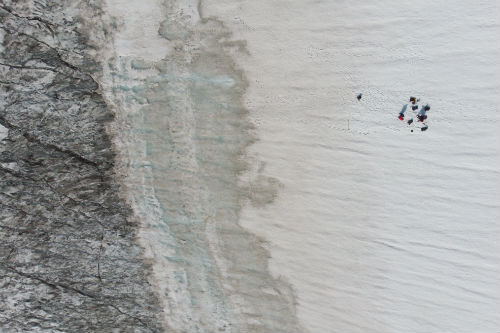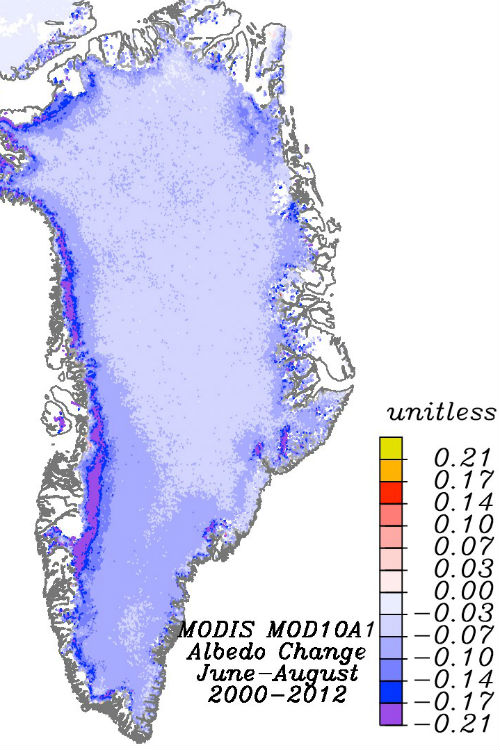The team includes Professor Martyn Tranter from Bristol’s School of Geographical Sciences, Professor Alex Anesio from Aarhus University in Denmark and Professor Liane Benning from the GFZ German Research Centre for Geosciences, Potsdam, Germany.
A dark band has been progressively growing down the western side of the Greenland Ice Sheet during the summer melt season for the last 20 years, causing increased melting of the darkening ice.
Professor Tranter said: “The darkening is caused by the numerous glacier algae that grow in this area, which are pigmented deep purple to shield their vital elements from the intense ultraviolet radiation in sunlight.
“There are so many of these deep purple algae that they look as black as the soot from tundra fires.”
Just why these glacier algae grow so densely is not really known at the moment, and neither is whether they will grow in the new melt zones on the ice sheet surface, to the north and to the ice sheet interior, as the climate continues to warm.
Questions such as this need answering if future sea level rise is to be predicted accurately, since Greenland melt is a major driver of current sea level rise.
The research project named DEEP PURPLE aims to answer these questions, combining curisoity driven science about how the glacier algae grow and interact with their icy habitat, and societally relavent research into the processes that lead to ice surface darkening that are needed by ice melt modellers.
The team will work around many different sites in Greenland, making measurements of surface darkening, glacier algae density, how much soot and dust the algae trap on the surface and the physical properties of the melting ice surface to finally understand how biological darkening occurs, and to preduct where and when it will occur in the future.
This type of research needs the expertise of glaciologists, microbiologists and particulate biogeochemists, working in synergy, because only with a knowledge of all three aspects of melting ice surfaces can biological darkening be understood.
A large fieldwork and helicopter budget is needed too to enable remote, inclement (to humans) icesheet surfaces to be studied.
DEEP PURPLE will host a team of nine post doctoral researchers and six PhD students, along with the three lead principal investigators.
Professor Tranter added:“This is a great opportunity to finally collect all the physical, chemical and biological measurements we need from around the Greenland Ice Sheet to finally understand the controls of the increasing amount of biological darkening that is occurring year by year.
“The Dark Snow and Black and Bloom Projects paved the way for DEEP PURPLE, and we are very confident of recruiting another set of talented young scientists who can drive the science forward another great step.
“We hope to undertake our first field season in 2020, and the New Year won’t come quickly enough for us to start the project.
“We are hugely priveleged and thankful to receive this amount of funding over six years, and we will work our hardest to ensure that the ERC gets full scientific value for the investment they have made in our quest to understand the biological darkening of ice.”
Professor Nishan Canagarajah, Pro Vice-Chancellor (Research and Enterprise) at the University of Bristol, said: “These grants foster research at the intellectual frontiers by enabling a small group of leading principal investigators to work together in new ways to address ambitious research problems, with an intention to enable transformative research not only at the forefront of European science but also to become a benchmark on a global scale.
“This prestigious grant is a fantastic achievement that will enable Martyn to pursue ground-breaking research into the Greenland Ice Sheet in collaboration with his fellow academic colleagues in Europe.”

